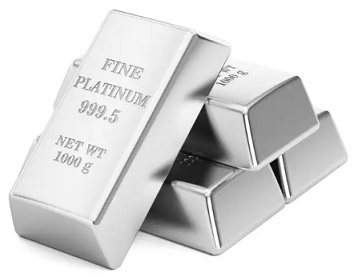| Uses | Jewelry; oxygen sensor in internal combustion engines; chemical and electrical industries; dentistry; windings of high�temperature furnaces; electroplating; photog�raphy; cancer chemotherapeutic agents |
| Chemical Properties | Platinum is a silvery to whitish-gray metal, that is malleable and ductile (Weast, 1988; Krebs, 2006). It is estimated that the average platinum concentration in the earth’s lithosphere ranges from 0.001 to 0.005 mg/kg (WHO, 1991). It has a vapor pressure of approximately 0mmHg (NIOSH, 2005). Platinum, depending on mining location, is found in sperrylite, cooperite, braggite, and copper–nickel sulfide ores, and in alloys with other members of the platinum group elements (PGE; iridium, osmium, palladium, ruthenium, and rhodium) (Dubiella-Jackowska et al., 2009; Weast, 1988; WHO, 1991). Both elemental platinum and platinum salts are used in industry. Elemental platinum is insoluble in water whereas many of the platinum salts are water soluble to varying degrees, depending on their specific chemical properties (WHO, 1991). Platinum metal is inert and resists corrosion (Krebs, 2006). However, platinum halide salts are considered potent allergens that have a high risk of causing sensitization (Linnett, 2005). Platinum bonds with halogens in its +2 and +4 oxidation state (Krebs, 2006). The charge of the salt and the presence and number of halides, especially chloride, in a complex platinum salt may affect the degree of mammalian sensitivity to a specific salt (Cleare et al., 1976; Mapp et al., 1999; Merget et al., 2000; Ravindra et al., 2004; Pepys, 1980).
 |
| Uses | Platinum is found in the environment naturally and from anthropogenic sources. Platinum is primarily used in industry as a catalyst, predominately for the production of vehicle catalytic converters. Platinum is also used in the chemical, electrical, glass, dental, healthcare, pharmaceutical, petroleum, and jewelry fields. In addition to its catalytic properties, platinum, in combination with cobalt, has powerful magnetic properties.
Platinum metal and its alloys have numerous applications. As a precious metal it is used extensively in jewelry. Other important applications include construction of laboratory crucibles and high temperature electric furnaces; in instruments as thermocouple elements; as wire; for electrical contacts; as electrodes; in dentistry; in cigarette lighters; and for coating missile and jet engine parts.
Platinum also is used extensively as a catalyst in hydrogenation, dehydrogenation, oxidation, isomerization, carbonylation, and hydrocracking. Also, it is used in organic synthesis and petroleum refining. Like palladium, platinum also exhibits remarkable ability to absorb hydrogen. An important application of platinum is in the catalytic oxidation of ammonia in Ostwald's process in the manufacture of nitric acid. Platinum is installed in the catalytic converters in automobile engines for pollution control. |
| Description | Platinum was discovered in Colombia, South America by Ulloa in 1735 and six years later in 1741 by Wood. The metal was isolated from native platinum by Delisle in 1775 and produced in malleable form by Chabaneau in 1786. Wollaston in 1803 developed a method of obtaining pure malleable platinum from crude platinum by extraction with aqua regia. The process led to the discovery of two other platinum group metals, palladium and rhodium, that were found in the aqua regia extract after platinum precipitated. Platinum derived its name from platina originating from the Spanish word plata for silver, because it was thought to be a trivial unwanted material associated with gold in gold mines of Central America.
Platinum occurs in nature as a bright-white cubic crystalline solid with metallic luster associated with other noble metals of its group. Platinum also occurs as the mineral sperrylite, PtAs2, found as tin-white brittle cubic crystals containing 52−57% platinum in certain nickel-bearing deposits. Some other minerals of platinum are cooperite PtS (Pt 80-86%); and braggite(Pt, Pd, Ni)S (Pt 58-60%). The abundance of platinum in the earth’s crust is estimated to be 0.005 mg/kg. |